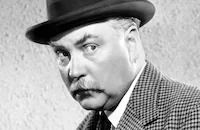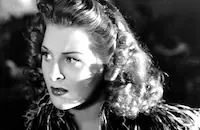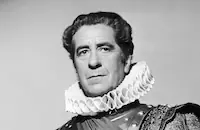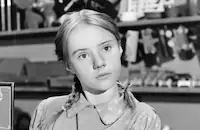Eagle Squadron
Cast & Crew
Arthur Lubin
Robert Stack
Diana Barrymore
John Loder
Eddie Albert
Nigel Bruce
Film Details
Technical Specs

Synopsis
Prior to the United States' entrance into the war, a group of young Americans--Chuck S. Brewer, Johnny M. Coe and Wadislaw Borowsky--cross the Atlantic to fight the Nazis with the British Royal Air Force. They are assigned to the Eagle Squadron, which is made up of American flyers. Aboard their transport plane are squadron leader Paddy Carson, section leader Anne Partridge and transport aviatrix Nancy Mitchell. Chuck takes an immediate interest in Nancy, but she tells him that her boyfriend is his fellow flyer, Hank Starr. Just before their first mission, the flyers are warned about the German's new plane, which is twice as deadly as the previous one. While Johnny takes the company's feline mascot along as a good-luck charm, another flyer, Leckie, receives a garter from a female British spotter. The squadron then successfully attacks a German air force base. On the way back, however, Johnny and Chuck are shot down. Chuck parachutes into the sea and is successfully rescued, but Johnny is killed. A German flyer later parachutes the kitten back to the squadron, with a challenge for other flyers to join Johnny in death. When Chuck complains about the English's callous attitude toward death, he is informed that Johnny was killed because the two new flyers broke formation and that two other pilots were killed as well trying to protect them. Later, Chuck goes to a military dance, where he becomes reacquainted with Anne. During the dance, a German squadron attacks and Chuck helps save a young man's life. Anne later makes a date with Chuck, but when Carson hears of it, he tries to warn the young pilot off, but the jealous Chuck rebukes him. Anne's date turns out to be an excursion with a group of evacuated children. After a German raid interrupts their picnic, Carson whisks Anne away to London, much to Chuck's annoyance. The British then plan a commando raid into France, to steal one of the new German planes. Carson is set to lead the raid, and he requests that Chuck and Wadislaw join him. On his one-day leave, Chuck travels to London, in hopes of finding Anne and Carson. During a blitzkrieg, he finds the two at a burning hospital. Anne is injured leading a group of patients out of the burning building, but she finds there what she and Carson have been seeking: her missing father, pacifist Sir James Partridge. He dies in her arms, and Carson explains to Chuck that Partridge had flown incognito as a gunner on a British bomber, in attempted retribution to his dead soldier son Eric, who had been Carson's best friend. Now knowing the truth, Chuck proposes to Anne, but she refuses, stating that everyone she allows herself to love has been killed in the war. As the commando raid begins, Wadislaw takes Johnny's kitten along for luck. As a diversion, the commandos plan to attack the German air field, allowing Carson and the flyers to sneak onto the base in search of the plane. When the kitten wanders away from Wadislaw, however, he beings shooting. With the element of surprise lost, the attack is called off, but Wadislaw is killed and Carson fatally wounded. While Chuck stays behind with the injured squadron leader and steals one of the German "Leopard" planes, Carson is killed providing ground cover. Chuck then shoots down three German planes and successfully lands the stolen plane on British soil. Chuck and Anne are both decorated for their bravery, but the ceremony is cut short by a German raid. Chuck kisses Anne on the cheek, then takes to the air once more.

Director
Arthur Lubin
Cast

Robert Stack
Diana Barrymore

John Loder

Eddie Albert

Nigel Bruce

Leif Erikson
Edgar Barrier
Jon Hall

Evelyn Ankers

Isobel Elsom

Gladys Cooper

Alan Hale Jr.

Don Porter
Edmund Glover
Stanley Smith
Howard Banks
Richard Crane
Clarence Straight
Richard Davies
Harold Landon
Todd Karns
Charles King
Donald Stuart
Frederic Worlock

Stanley Ridges

Robert Warwick
Richard Fraser
Gavin Muir
Harold De Becker

Rhys Williams

Paul Cavanaugh

Gene Reynolds

Alan Napier
Jill Esmond

Queenie Leonard
Olaf Hytten

Ian Wolfe
Carl Harbord

Charles Irwin
Mary Carr
Simon Olivier
William Severn
Linda Bieber
Quentin Reynolds
Eddie Hall
John Estes
Lee Bennett
Paula Allen
Radford Allen
Rene Austin
Wilda Bieber
Howard Blanchard
Dennis Chaldecott
Rae Collet
Donetta Deane
Jenny Elwes

Peggy Ann Garner
Mary Lou Harrington
Rodney Leftwich
Tommy Martin
Clare Sandars
Yvonne Severn
Billy Sheffield
Sandy Tucker

Ivan Simpson
Jessica Newcombe
John Burton
Bruce Lester
James Seay
Keith Hitchcock
Florence Gill
Harry Stubbs
Alec Harford
Harry Allen
David Clyde
Colin Kenny
James Craven
John Holland
Eric Wilton
Noel Ruddy

Kenneth Macdonald
Carol Curtis-brown
Reginald Sheffield
Davis Roberts
Roland Varno
Tom Stevenson
Leslie Denison
Pax Walker
Irene Tedrow
James Eagles
Heather Wilde
Viola Moore
Joyce Wynn
Pauline Bruce
Oscar Loraine
Fred Cavens
Paul Bryar
Cyril Thornton
Arthur Gould-porter
Guy Kingsford
Robert Street
Roy Claar
James Harker
Bruce Wyndham
Hans Herbert
John Bleifer
Louis Adlon
Walter Bonn
Rex Lease
Crane Whitley
Carl Roth
Vicki Campbell

Audrey Long
Frank Penny
Barry Bernard
Joan Coxwell
Paula Francis
Herbert Evans
Kate Lawson
Stanley Smith
Richard Davis
John Walsh
Gerard Cavin

Peter Lawford
Betty Camp
Crew
Woody Bredell
Bernard B. Brown
Philip Cahn
Charles Carroll
Stanley Cortez
John Fulton
R. A. Gausman
Alexander Golitzen
Joan Hathaway
John M. Hill R.a.f.
Doris Lavelle
Annette Mills
Jack Otterson
M. Pierre
Charles Previn
Norman Reilly Raine
Quentin Reynolds
Ernest B. Schoedsack
Frank Skinner
Gil Valle
Walter Wanger
Harry Watts

Film Details
Technical Specs

Articles
Eddie Albert (1906-2005)
The son of a real estate agent, Albert was born Edward Albert Heimberger in Rock Island, Ill., on April 22, 1906. His family relocated to Minneapolis when he was still an infant. Long entralled by theatre, he studied drama at the University of Minnesota. After years of developing his acting chops in touring companies, summer stock and a stint with a Mexican circus, he signed a contract with Warner Bros. and made his film debut in Brother Rat (1938). Although hardly a stellar early film career, he made some pleasant B-pictures, playing slap happy youths in Brother Rat and a Baby (1940), and The Wagons Roll at Night (1941).
His career was interrupted for military service for World War II, and after his stint (1942-45), he came back and developed a stronger, more mature screen image: Smash-Up: The Story of a Woman (1947); Carrie (1952); his Oscar® nominated turn as the Bohemian photographer friend of Gregory Peck in Roman Holiday (1953); a charming Ali Hakim in Oklahoma (1955); and to many critics, his finest hour as an actor, when he was cast unnervingly against type as a cowardly military officer whose lack of commitment to his troops results in their deaths in Attack! (1956).
As he settled into middle-age, Albert discovered belated fame when he made the move to Hooterville. For six seasons (1965-71), television viewers loved Eddie Albert as Oliver Wendal Douglas, the bemused city slicker who, along with his charming wife Lisa (Eva Gabor), takes a chance on buying a farm in the country and dealing with all the strange characters that come along their way. Of course, I'm talking about Green Acres. If he did nothing else, Alberts proved he could be a stalwart straight man in the most inane situations, and pull it off with grace.
After the run of Green Acres, Albert found two of his best roles in the late stages of his career that once again cast him against his genial, good-natured persona: the fiercly overprotective father of Cybill Shepherd in The Heartbreak Kid (1972), for which he earned his second Oscar® nomination; and the sadistic warden in Robert Aldrich's raucous gridiron comedy The Longest Yard (1974). Soon, Albert was in demand again, and he had another hit series, playing a retired police officer who partners with a retired con artist (Robert Wagner) to form a detective agency in Switch (1975-78).
The good roles slowed down slightly by the dawn of the '80s, both film: The Concorde: Airport '79 (1979), How to Beat the High Co$t of Living (1980), Take This Job and Shove It (1981); and television: Highway to Heaven, Murder, She Wrote, Thirtysomething, offered him little in the way of expansion. Yet, Albert spent his golden years in a most admirable fashion, he became something of activist for world health and pollution issues throughout the latter stages of his life. It is widely acknowledged that International Earth Day (April 22) is honored on his birthday for his tireless work on environemental matters. Albert was married to famed hispanic actress Margo (1945-85) until her death, and is survived by his son, actor Edward Albert, a daughter, and two granddaughters.
by Michael T. Toole

Eddie Albert (1906-2005)
Robert Stack, 1919-2003
Stack was born in Los Angeles on January 13, 1919 to a well-to-do family but his parents divorced when he was a year old. At age three, he moved with his mother to Paris, where she studied singing. They returned to Los Angeles when he was seven, by then French was his native language and was not taught English until he started schooling.
Naturally athletic, Stack was still in high school when he became a national skeet-shooting champion and top-flight polo player. He soon was giving lessons on shooting to such top Hollywood luminaries as Clark Gable and Carol Lombard, and found himself on the polo field with some notable movie moguls like Darryl Zanuck and Walter Wanger.
Stack enrolled in the University of Southern California, where he took some drama courses, and was on the Polo team, but it wasn't long before some influential people in the film industry took notice of his classic good looks, and lithe physique. Soon, his Hollywood connections got him on a film set at Paramount, a screen test, and eventually, his first lead in a picture, opposite Deanna Durbin in First Love (1939). Although he was only 20, Stack's natural delivery and boyish charm made him a natural for the screen.
His range grew with some meatier parts in the next few years, especially noteworthy were his roles as the young Nazi sympathizer in Frank Borzage's chilling The Mortal Storm (1940), with James Stewart, and as the Polish flier who woos a married Carole Lombard in Ernst Lubitsch's To Be or Not to Be (1942).
After serving as a gunnery officer in the Navy during World War II, Stack returned to the screen, and found a few interesting roles over the next ten years: giving Elizabeth Taylor her first screen kiss in Robert Thorp's A Date With Judy (1948); the leading role as an American bullfighter in Budd Boetticher's The Bullfighter and the Lady (1951); and as a pilot in William Wellman's The High and the Mighty (1954), starring John Wayne. However, Stack saved his best dramatic performances for Douglas Sirk in two knockout films: as a self-destructive alcoholic in Douglas Sirk's Written on the Wind (1956), for which he received an Academy Award nomination for supporting actor; and sympathetically portraying a fallen World War I pilot ace who is forced to do barnstorming stunts for mere survival in Tarnished Angels (1958).
Despite proving his capabilities as a solid actor in these roles, front rank stardom oddly eluded Stack at this point. That all changed when Stack gave television a try. The result was the enormously popular series, The Untouchables (1959-63). This exciting crime show about the real-life Prohibition-era crime-fighter Eliot Ness and his G-men taking on the Chicago underworld was successful in its day for several reasons: its catchy theme music, florid violence (which caused quite a sensation in its day), taut narration by Walter Winchell, and of course, Stack's trademark staccato delivery and strong presence. It all proved so popular that the series ran for four years, earned an Emmy for Stack in 1960, and made him a household name.
Stack would return to television in the late '60s, with the The Name of the Game (1968-71), and a string of made-for-television movies throughout the '70s. His career perked up again when Steven Spielberg cast him in his big budget comedy 1941 (1979) as General Joe Stillwell. The film surprised many viewers as few realized Stack was willing to spoof his granite-faced stoicism, but it won him over many new fans, and his dead-pan intensity would be used to perfect comic effect the following year as Captain Rex Kramer (who can forget the sight of him beating up Hare Krishnas at the airport?) in David and Jerry Zucker's wonderful spoof of disaster flicks, Airplane! (1980).
Stack's activity would be sporadic throughout the remainder of his career, but he returned to television, as the host of enormously popular Unsolved Mysteries (1987-2002), and played himself in Lawrence Kasden's comedy-drama Mumford (1999). He is survived by his wife of 47 years, Rosemarie Bowe Stack, a former actress, and two children, Elizabeth and Charles, both of Los Angeles.
by Michael T. Toole
Robert Stack, 1919-2003
Quotes
Trivia
Notes
The opening credits include the following acknowledgment: "This production was made possible through the cooperation of The British Air Ministry, The British Ministry of Information, The Royal Air Force [and] The Eagle Squadron of the R.A.F." The film then begins with an extended foreword, written and spoken by noted war correspondent and radio commentator Quentin Reynolds. While Reynolds explains the role of the Eagle Squadron in the defense of England, actual footage of the squadron in action is shown. Reynolds had previously written about the squadron in his book Only the Stars Are Neutral. According to Universal press materials, Reynolds stated in his book that Gene "Red" Tobin, a member of the squadron who had worked as an M-G-M office boy, was killed in an air battle the same day Reynolds had planned a birthday party for him in London. Press materials add that the film opens with a shot of Tobin flying his Spitfire plane, and that this was the last footage taken of the flyer. Other pilots shown during the foreword include Flying Officers Bill Geiger, Wally Tribkin, Ed Bateman, Tom Wallace, Hilliard Fenlaw and Anderson; Pilot Officers Tom McGerty, John Flynn, Dowling and Bono; and Squardron Leader Peterson. According to Hollywood Reporter, Reynolds' foreword was to be broadcast over 500 radio stations simultaneously with the film's premiere. As depicted in the film, the Eagle squadron was a unit in the British Royal Air Force, made up of American volunteers. According to PM (Journal), it came into existence in October 1940, during the height of the Battle of Britain, one year prior the United States's entrance into World War II. According to the New Yorker, these American flyers were paid a mere sixteen dollars a week.
According to a Life magazine feature article, producer Walter Wanger sent fellow producer Merian C. Cooper to England to work with the British Air Ministry and obtain film of actual squadron raids by the American flyers. That footage included shots of the squadron flying over the cliffs of Dover, attacks on their planes by German anti-aircraft guns in France, and pilots bailing out over the English Channel. In a paid advertisement in Variety on June 10, 1942, Universal claimed that this film was the first to show actual footage of British commando raids, British Spitfire airplanes in action, the British Mosquito Fleet patroling the English Channel and the British Women's Auxiliary Aircraft Force. New York Times stated in November 1941 that the footage was actually shot by Ernest B. Schoedsack and Harry Watts, and that Wanger originally planned to shoot the picture entirely in England, with the actual members of the Eagle squadron playing themselves.
According to a July 1941 Hollywood Reporter news item, Wanger and Cooper intended to make the picture for United Artists distribution, with Harry Watts as the director. In November 1941, however, Hollywood Reporter announced that Wanger had left United Artists and was planning to produce the film himself, without a distributor. On November 18, 1942, however, the producer entered into an agreement with Universal to produce the film in Hollywood with actors, and integrate into the fictionalized account previously shot footage of the real Eagle squadron. According to Hollywood Reporter, Wanger planned to pre-sell the film in January 1942 using a transcontinental radio show, a cartoon strip and apparel tie-ins featuring the insignia of the Eagle squadron. According to Universal publicity materials, the insignia for the Eagle squadron, which was an eagle wearing boxing gloves, was designed by the Walt Disney Studio, under an agreement with the British government. As such, Wanger was required to obtain permission from Disney to reproduce the insignia.
Eagle Squadron marked the feature film debut of actress Diana Barrymore, the daughter of noted actor John Barrymore. Diana Barrymore was cast in the film in mid-December 1941, based on her performance in the Max Gordon Broadway stage production, The Land Is Bright. The 1958 Art Napoleon-directed film Too Much, Too Soon, starring Dorothy Malone and Errol Flynn, was based on her autobiography of the same name and centered on her brief, unsuccessful film career and decline into alcoholism. She died in 1960 at the age of 39. In January 1942, Hollywood Reporter reported that Jon Hall had been cast in Eagle Squadron, under an agreement between Universal and independent producer Samuel Goldwyn, in which the two organizations agreed to share the actor's contract. John Loder was also cast in the film at this time, and was released from his commitment to perform in the Warner Bros. film Desperate Journey (see entry above) in order to appear. Hollywood Reporter further reported that portions of the picture were shot at Portuguese Bend, near the Palos Verdes Hills in California, in mid-March 1942.
The Daily Variety review states that technical advisor John M. Hill, an actual member of the Eagle squadron who was on leave from the RAF due to a war injury, was one of only four flyers in his seventeen-man squadron to survive. According to Universal publicity materials, Hill worked on the production for eight weeks. Hollywood Reporter claimed on March 12, 1942 that seven-year-old Simon Tarquin Olivier, the son of noted actor Laurence Olivier and actress Jill Esmond, was making his film debut with his mother in this picture. Hollywood Reporter also stated in April 1942 that actor Stanley Smith replaced Frank Kelly in the role of "Bell," as Kelly had been drafted into the U.S. Army. Hollywood Reporter production charts include Charles Lang in the cast, but his participation in the released film has not been confirmed. According to the Hollywood Reporter review, the song "Boomps-a-Daisy" was the "current British dance craze."
The film's world premiere, which was held at the Orpheum Theater in San Francisco in late June 1942, raised over $200,000 in war bonds and war stamps. This conflicts, however, with Film Daily, which states that the film's national release date was June 16, 1942. Upon its release, the film received a front-page editorial endorsement in the Harrisburg (PA) Telegraph, which stated that Eagle Squadron was the "one picture every resident of Harrisburg, and the United States of America, should see." In late June 1943, Hollywood Reporter claimed that producer Howard Hawks wanted to re-use the cast of this film-Diana Barrymore, Robert Stack, Evelyn Ankers, Jon Hall, Nigel Bruce and Leif Erickson-in his planned World War II production Corvettes in Action, and that he was willing to change his production schedule in order to make this happen. Hawks's film was later produced under the title Corvette K-225 (see entry above), without the aforementioned actors. In an August 1943 New York Times interview, Wanger complained about the severe lack of military cooperation in the making of this and other war-themed films, which he claimed accounted for the poor quality of these productions. According to an unidentified item found at the AMPAS library, international film financier Jacques Grinieff later acquired a fifty percent interest in Eagle Squadron.














